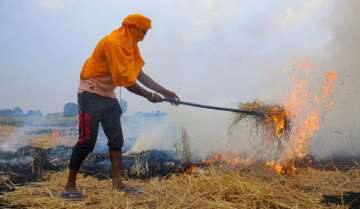The share of stubble burning in Delhi's PM2.5 pollution rose to 36 per cent on Thursday, the maximum so far this season, according to a central government air quality monitoring agency. The number of farm fires in neighbouring states was 2,912 on Wednesday, the highest so far this season, according to the Ministry of Earth Sciences' air quality monitor SAFAR. "Stubble burning share in Delhi PM2.5 concentration was 36 per cent on Thursday," it said.
It was 18 per cent on Wednesday, 23 per cent on Tuesday, 16 per cent on Monday, 19 per cent on Sunday and nine per cent on Saturday.
Delhi's air quality entered the "severe" category -- for the first time since January -- as calm winds and low temperature allowed the accumulation of pollutants amid a spike in farm fires.
"Extremely calm surface and boundary layer winds along with the low nighttime boundary layer height resulted in low ventilation.. practically stagnant, no dispersion condition has resulted in the current situation," SAFAR said.
Delhi recorded an air quality index (AQI) of 402 at 2 pm. The 24-hour average AQI was 297 on Wednesday, 312 on Tuesday, 353 on Monday, 349 on Sunday, 345 on Saturday and 366 on Friday.
An AQI between 0 and 50 is considered 'good', 51 and 100 'satisfactory', 101 and 200 'moderate', 201 and 300 'poor', 301 and 400 'very poor', and 401 and 500 'severe'.
SAFAR said the accumulation of locally generated pollutants and increased external intrusion due to north-northwesterly boundary level winds from regions where stubble is burnt were major factors for the increase in PM 2.5 levels.
An increase in surface wind speed and better ventilation conditions are likely to "significantly" improve the situation by Saturday, it said.
According to the India Meteorological Department, the predominant wind direction on Thursday was northerly and the maximum wind speed was 8 kilometers per hour.
The minimum temperature was recorded at 12.5 degrees Celsius -- the lowest in October in 26 years.
Calm winds and low temperatures trap pollutants close to the ground, while favourable wind speed helps in their dispersion.
(With inputs from PTI)
Latest India News
